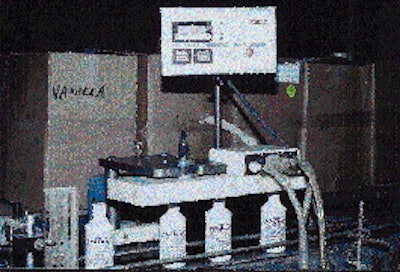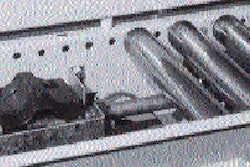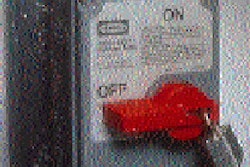In offices, manufacturing plants and other institutions around the country, chances are the maintenance staff has used cleaning products manufactured by The State Chemical Mfg. Co., Cleveland, OH. This venerable producer operates seven filling lines at its main headquarters plant, almost exclusively filling high-density polyethylene bottles from 1 oz to gallons and even larger. Although it operates out of several buildings in an aging industrial area of Cleveland, it's working hard to deliver better products in a more timely fashion to its customers. State's packaging lines are a combination of new and existing equipment with a healthy dose of manual labor. That's necessary because the company packs so many different products in so many different sizes, and it tries to do so while keeping minimum inventories in its warehouse. How can it accomplish this? * To upgrade the quality of its packaging, State began an extensive program that led to the purchase of three induction sealers from Pillar Technologies (Hartland, WI) on its most productive packaging lines. It made the first sealer portable so it could be moved from line to line. The mouth seals were so well received by customers that the plant added two more to its other production lines. * With bottle seals, State found that some seal laminations were not compatible with certain highly alkaline products. As a result, the company uses foam liners on a few of its products. * For the last few years, State has relied on a unique computer program for production forecasting and scheduling. The Manufacturing Resource Planning Two (MRP II) computer program, developed with Arthur Andersen Consulting (Chicago, IL), helps State plan not only its production, but also its purchases of both raw materials and packaging components. Keeping up with State's regular flow of new products under the State and subsidiaries' private labels is a big enough job. Keeping track of containers, decorating, foil seals and product formulations is a real challenge, particularly with 2겨 SKUs. It's also been a labor of love for Allen M. Platek, vice president, materials management. Citrus tough to pack State Chemical may be an 84-year-old company, but it has a very contemporary attitude that keeps it in tune with its customers. Platek proudly showed Packaging World the company's pollution prevention policy. In no small way, that policy-and the marketplace-led State to reformulate many products to use water-based or citrus-oil-based cleaners. Although the products are better for the environment, they can be very troublesome to contain. State manufactures a line of orange oil products that it packs into F-style gallon jugs of high-density polyethylene. Platek discovered that this combination of product and package was causing some returns because of leakers. "I'd estimate we were getting about a dozen returns each month because of leakers," says Platek. "Since we were shipping out tens of thousands of containers, the percentage wasn't terribly significant. But it reflected badly on our company." The issue was on his mind as Platek visited Pack Expo 92. The use of induction sealing to avoid leakers wasn't at the top of his list of solutions. First, State investigated the use of different components and even altering the package, for example to a bag-in-box style. "In the end, induction sealing was most attractive because it still let us use all our present equipment, it's a noninvasive process that has no moving parts, and we could use the same bottles and closures. So it appeared to be the most economical," Platek notes. The company contacted the three leading manufacturers and it began to examine the different systems. State's engineers preferred the Foiler from Pillar, which was then a brand new model. One main advantage to this model is that the entire unit isn't water cooled, just the actual sealing head. This makes it easier to use, State's plant engineers say. It also permitted the company to make its first Foiler portable. "Before we added our second and third induction sealers, we were using the sealer to attack only the bottles we knew had leaker problems," recalls Platek. "So I asked our maintenance people to find a way to make the sealers portable so we could move it from line to line." The mechanics devised a rack that holds the sealing head, and a way to slide that rack and the base unit onto a forklift truck. It worked well, but it was soon superseded by State's desire to add seals to more bottles. Not just for leakers The company was so impressed by the results of the seals on its gallon jugs that it decided to try induction seals on its other sizes as well. Although the quart line had no noticeable problem with leakers, the company began to see the inner seal as a recognized package improvement. And customers really liked it. The second Foiler was added to the quart line and the third sealer was added last year to State's "newest" line, one that runs bottles sized from a 1-oz sample up to 16 oz. Although there is some new equipment on that line, it also contains older equipment from other packaging lines. While the units are more or less permanently installed on each line, they share an advantage that was originally developed to make the unit portable. Because each sealing head is mounted to a floor-mounted rack, it's independent of a conveyor line. That means it's unaffected by the conveyor's vibration and shock, so it's less likely to need adjusting. With a handwheel height adjustment, it's easier to position the seal head properly for the different heights of containers or closures. On the gallon line, for example, the heights of the rounds and F-style jugs are different; on the quart line, the bottles are the same height, but the closures aren't. State uses a flip-top cap on some products that is taller than the regular screw caps. "We mark the proper positions for all these caps on the units so adjusting is quick," Platek says. "We also have the top of the sealing head marked to show the proper position over the conveyor. These have to be canted a bit from the line flow to ensure the magnetic flux is applied to the entire cap." That, he says, is the only disadvantage of not installing the head onto the conveyor; if it gets moved a bit, it has to be repositioned. State has five lead operators who are responsible for line changeovers and are trained to understand which machines have to be adjusted for a different container. Backing them up, a Quality Control inspector always checks out finished packages before a new run can go into production. Solving other problems Since all of State Chemical's bottles are HDPE, it expected it could use the same inner seal material for all. What the company found is that not all bottles are created equal, just as all products don't have the same characteristics. When State began to seal the necks of quart bottles, it discovered that the seals weren't always reliable. After investigating further, it found the problem was being caused by out-of-spec bottles: the top flat surface of the bottle finish, the land, was too narrow. "We discovered that the land area on some bottles was too small, clearly not within our written specification," Platek recalls. "This solution also remedied another related problem. We had been using a gasket-type seal on the bottles that we topped with flip-top caps. But the seals weren't as consistent as we wanted. By remolding the bottles with the land area in spec, we now had enough surface to get uniform seals with gasket liners." State Chemical has various sources for inner seals or for closures. Most of State's liners are a lamination of aluminum foil/polyester/low-density PE. 'Missing' seals Not all problems with seals were traced to out-of-spec bottles. State was filling a variety of products into gallon bottles that received the induction seals through the Pillar units. And in fact, State Chemical sales people were actively promoting the seals as an improved feature to customers. Customers for some products simply didn't receive bottles with intact seals. More care was taken to adjust the height of the seal head properly during package changeover, and in-plant quality checks were more frequent. Yet their inner seals remained inconsistent. So the company sent staff out into the field to perform a seal audit. The team discovered that although orders went out from Cleveland with seals in place, a week or two later the seals were completely gone when the product arrived at the end user's location. Eventually, the culprit was identified: the high alkalinity of some products. "Our chemists found that the highly alkaline products were actually 'eating' the foil seals on the bottle," reports State's vice president for materials management. "So we've gone back to foam seals on these products, while we try to find a material that is compatible." Ironically, those same products packed into quart bottles didn't have the missing-seal problem. The only difference between the two containers is that the quart bottle closures have a pulp backing while the gallon caps do not. And the polyethylene layer is a bit heavier too, says Platek. Customers appreciate seals The response from State Chemical customers has been all positive, the company says. And not just because returns have been reduced. "There's also a safety factor on their side. They know they can depend on receiving our bottles intact, and the inner seals can prevent problems in their use. They don't always handle them carefully. "Our sales people have been using the seals as a marketing advantage over our competition," Platek points out. "We know it's helped us grow this business." The cost of returns caused by leakers is tremendous, he says. Every time you have to reship an order, it costs your company an average of $100 to rehandle that order. Still, buying the sealers was hard to justify just from an economic standpoint, Platek recognizes. "It's customer satisfaction that really improves. Not only do our customers appreciate fewer packages with seal problems, but so do our shippers." Since the company started adding the inner seals, the level of all types of transit damage has dropped by 60 to 70%. The incidence of leakers alone has declined by at least 90%, the company reports. "This is worth a lot of money to us," Platek says. "We're convinced it's worth it. Several of our customers called our service representatives to say it was a good safety idea." Cheaper materials While the company admits that it costs more money to add the seals, it has found that the liners themselves are less costly than the previous nonsealing liners it used. This even surprised Allen Platek. With the induction-sealable liner in place, screw caps for gallon jugs average 0.7¢/unit less than caps with foam liners. Costs are closer for the screw caps for State's quart bottles, 0.2¢/unit less than caps with pulp liners. Caps in a variety of sizes with a range of liners is just a small part of the container purchasing responsibilities at State Chemical. Containers from one ounce up to gallons and even into intermediate bulk size must all be managed as well. Until four years ago, this was a monumental task that was leading to ever larger parts inventories. At the same time, the company was trying to modernize its production scheduling for the seven packaging lines. With the help of Arthur Andersen Consulting Services, State installed a computer software program called MAC-PAC® OPEN that Platek says is both a materials and a manufacturing resource planning (MRP II) system. This custom program has done wonders for State Chemical's scheduling and purchasing functions. Working from its AS-400 mainframe computer from IBM (Armonk, NY), the program uses historical data and forecasts that State keys in. From this information, the software generates production schedules for the packaging lines as much as four to five months ahead. Later, the program offers even more specific scheduling needs six weeks ahead. "At that time, the MRP system tells us what raw materials and packaging components we need to order," says Platek. "When necessary, it will alert us even sooner, for example where we have 20-week lead times on materials or package components." The key to the program's success is that it keeps space freed up in State Chemical's warehouse. "It really helps us keep inventory levels down. Even though our sales have grown dramatically in the last few years, our inventory levels of finished goods or raw materials have remained constant, or even gone down," Platek reports. That's critical to State Chemical because warehouse space is at a premium in its landlocked area. This has also meant that State works more closely with vendors to get better service. "We're negotiating with our suppliers to give us less-than-truckload deliveries at truckload prices," Platek states. "To gain that cooperation, we're concentrating our purchasing with fewer vendors. So we're saying, 'We'll be buying more from you. We just want it in smaller quantities.' Our primary corrugated supplier delivers several times a week to us. That really helps us keep our inventory levels low. "Just a few years ago, we used to package in runs as long as possible to put as much product in the warehouse as possible," says Platek. "Today, the philosophy is only to make as much product as the program tells us will be needed. Not only does this lower our inventory levels, it creates a high inventory turnover rate."



























